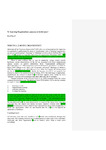Learning Organizations: panacea or irrelevance?
| dc.contributor.author | Sheaff, Rod | |
| dc.contributor.editor | Örtenblad A | |
| dc.contributor.editor | Abrahamson Löfström C C | |
| dc.contributor.editor | Sheaff | |
| dc.date.accessioned | 2016-11-07T23:11:09Z | |
| dc.date.available | 2016-11-07T23:11:09Z | |
| dc.date.issued | 2016-01-01 | |
| dc.identifier.isbn | 9781138825697 | |
| dc.identifier.uri | http://hdl.handle.net/10026.1/6682 | |
| dc.description.abstract |
Advocates of the “Learning Organization” (LO) offer a set of prescriptions for improving an organization’s performance by means of transforming it into a “learning” organization, not just an “understanding”, “knowing” or “thinking” one (Giesecke & McNeil, 2004). The LO is thus regarded as a specific, ideal form of organization (Örtenblad, 2001). This chapter considers how the LO ideal would have to be interpreted or altered to maximise its relevance to health-care organizations. There is some evidence that, at least in commercial settings mostly outwith healthcare, certain characteristics of the LO are associated with faster organizational change, product or service introduction, better “organizational performance” (Kontoghiorghes et al., 2005) (sometimes equated with financial performance, see Davis & Daley, 2008; Ellinger et al., 2002) and “competitive advantage” (Barringer & Harrison, 1991; Kontoghiorghes et al., 2005; Mowery et al., 1996). Accordingly, the LO has joined the list of managerial innovations. Mostly the literature on LOs is not scientific but normative, indeed often uncritical of the LO (Tsang, 1997). The wide range of applications, organizations and contexts to which the LO has been applied justify calling the LO a “panacea”. A plethora of consultancies and others offer it for sale to managers. Various definitions of the LO exist (Crites et al., 2009, categorize them) but certain common characteristics recur. Örtenblad and Koris (2014) define a LO as one that contains (or ought to contain) all four of the following: 1. Learning at work; 2. Organizational learning; 3. Learning structures; 4. A climate for learning. | |
| dc.format.extent | 227-244 | |
| dc.language.iso | en | |
| dc.publisher | Routledge | |
| dc.relation.ispartof | Management Innovations For Healthcare Organizations: Adopt, Abandon Or Adapt? | |
| dc.subject | Learning organisation | |
| dc.subject | healthcare | |
| dc.title | Learning Organizations: panacea or irrelevance? | |
| dc.type | chapter | |
| plymouth.publication-status | Published | |
| dc.identifier.doi | 10.4324/9781315739786 | |
| plymouth.organisational-group | /Plymouth | |
| plymouth.organisational-group | /Plymouth/Faculty of Health | |
| plymouth.organisational-group | /Plymouth/REF 2021 Researchers by UoA | |
| plymouth.organisational-group | /Plymouth/REF 2021 Researchers by UoA/UoA20 Social Work and Social Policy | |
| plymouth.organisational-group | /Plymouth/Research Groups | |
| plymouth.organisational-group | /Plymouth/Research Groups/FoH - Community and Primary Care | |
| plymouth.organisational-group | /Plymouth/Research Groups/Institute of Health and Community | |
| plymouth.organisational-group | /Plymouth/Users by role | |
| plymouth.organisational-group | /Plymouth/Users by role/Academics | |
| plymouth.organisational-group | /Plymouth/Users by role/Researchers in ResearchFish submission | |
| dc.publisher.place | New York | |
| dc.rights.embargoperiod | Not known | |
| rioxxterms.versionofrecord | 10.4324/9781315739786 | |
| rioxxterms.licenseref.uri | http://www.rioxx.net/licenses/all-rights-reserved | |
| rioxxterms.type | Book chapter |


